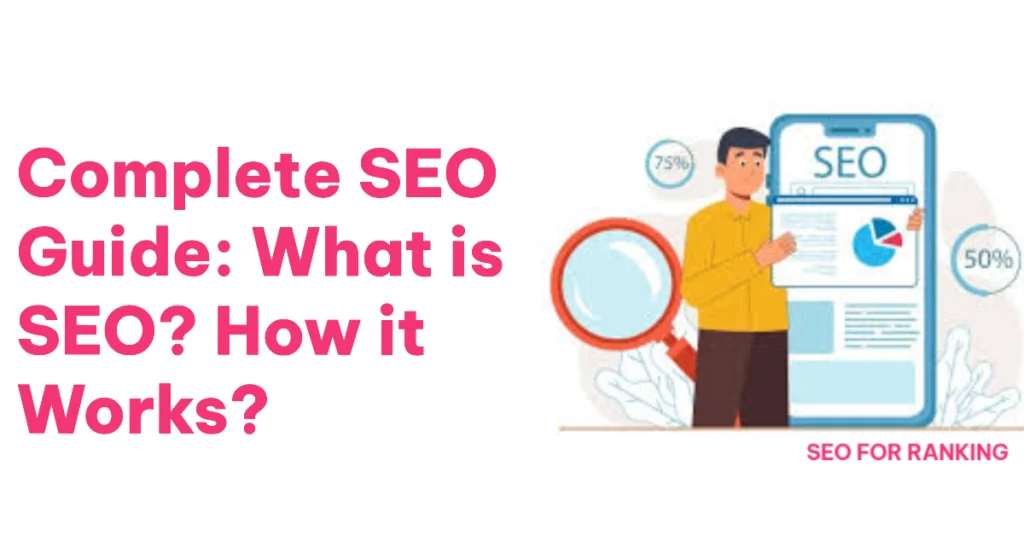1. Introduction
Search Engine Optimization (SEO) has become an integral part of digital marketing, driving organic traffic and boosting online visibility. In this guide, you’ll discover what SEO is, how it works, and actionable strategies to optimize your website for better search engine rankings. Whether you’re a beginner or looking to refine your skills, this guide has everything you need to get started.
2. What Is SEO?
Definition of SEO
Search Engine Optimization (SEO) is the process of optimizing a website to improve its visibility on search engines like Google, Bing, and Yahoo. The ultimate goal is to attract more organic traffic by ranking higher in search results.
Why SEO is Important
- Increases Visibility: A higher rank on search engines means greater visibility to potential visitors.
- Builds Trust: Websites on the first page of search results are perceived as more credible.
- Cost-Effective Marketing: Organic traffic eliminates the need for expensive ad campaigns.
Example: A small business optimizing its site for “affordable handmade jewelry” can attract local and global customers.
3. How SEO Works
1. Understanding Search Engines
Search engines use bots to crawl websites, index their content, and rank pages based on relevance and quality. This ranking process depends on factors like keywords, backlinks, and user engagement.
2. How Keywords Play a Role
Keywords are the phrases users type into search engines. By optimizing your content with relevant keywords, you signal to search engines that your page is the best match for the query.
Step-by-Step Process
- Conduct keyword research to identify target phrases.
- Optimize on-page elements (titles, meta descriptions, headers).
- Build quality backlinks.
- Monitor and adjust based on performance metrics.
4. Types of SEO
On-Page SEO
- Focus Areas: Title tags, meta descriptions, headers, and content.
- Best Practices: Use primary keywords naturally, optimize for user intent, and ensure content is valuable and informative.
Off-Page SEO
- Focus Areas: Link building, social signals, and online reputation.
- Best Practices: Acquire high-quality backlinks from authoritative sites and promote content on social media.
Technical SEO
- Focus Areas: Site speed, mobile-friendliness, and crawlability.
- Best Practices: Fix broken links, improve site structure, and implement structured data markup.
Local SEO
- Focus Areas: Google My Business, location-based keywords, and reviews.
- Best Practices: Optimize your profile, encourage positive reviews, and ensure NAP (Name, Address, Phone) consistency.
5. Keyword Research for SEO
Why Keyword Research Matters
Keywords help you understand what your audience is searching for. By targeting these phrases, you can create content that answers their queries.
How to Conduct Keyword Research
- Use tools like Google Keyword Planner or Ahrefs.
- Analyze competitors’ keywords.
- Identify long-tail keywords for niche topics.
6. Core SEO Practices
Writing SEO-Friendly Content
- Focus on user intent.
- Use primary and related keywords naturally.
- Ensure your content provides actionable value.
Improving User Experience (UX)
- Make navigation intuitive.
- Use engaging visuals and a clean layout.
Optimizing Meta Tags
- Write compelling meta descriptions.
- Use primary keywords in title tags.
7. Common SEO Mistakes to Avoid
- Keyword Stuffing: Overusing keywords can lead to penalties.
- Ignoring Mobile Optimization: Mobile-friendly sites rank higher.
- Neglecting Backlinks: Quality links enhance authority and rankings.
- Slow Loading Times: A delay in page load can hurt user experience and rankings.
8. Tracking and Measuring SEO Success
Key Metrics to Monitor
- Organic traffic
- Bounce rate
- Conversion rate
- Domain authority
Best Tools for SEO Analysis
- Google Analytics: Tracks traffic and user behavior.
- SEMrush: Monitors rankings and competitor analysis.
- Ahrefs: Identifies backlink opportunities.
9. Future of SEO
Emerging Trends
- Voice Search Optimization: Target conversational keywords.
- AI and Machine Learning: Algorithms prioritize high-quality, user-focused content.
- Video SEO: Optimize video descriptions and titles.
Adaptability is Key
The SEO landscape changes frequently. Staying updated with algorithm updates and trends ensures you remain competitive.
10. Conclusion
SEO is a multifaceted discipline that requires a mix of technical knowledge, creative content creation, and continuous analysis. By understanding what SEO is and how it works, you’re equipped to optimize your website and drive sustainable growth. Start implementing these strategies today and watch your SEO rankings improve!
